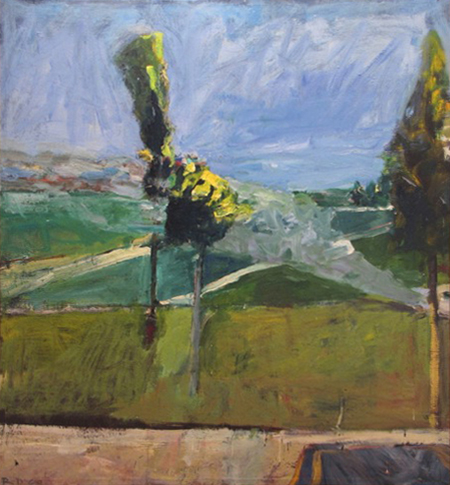
Continuing through October 18, 2014
The opening of the Anderson Collection at Stanford University has generated a lot of excitement in the Bay Area — not just for the stellar collection, displayed with great sensitivity and respect in the contemporary but restrained new building by Richard Olcott. This is partly because the selected 121 works will now live (and speak to each other) inside a kind of monument to the glory years of American art, before art became so entangled with fashion and marketing. We who in the current cultural moment yearn for seriousness and authenticity in contemporary art sometimes decry the recent trend, so it’s refreshing once again to examine work of high ambition. Christopher Knight in the Los Angeles Times recently pointed out that the collection’s aesthetic quality reflects the discernment of passionate, informed, old-school collectors:
"In some respects, the Stanford museum bids farewell to a vanishing culture — to a slower, more deliberate and more personal collecting style. The Andersons began collecting in the 1960s, when the art world was small and insular and museums weren't defined by a philosophy of grow-or-die corporatism. Buying and selling contemporary painting and sculpture had not become the spectator sport they are today, dominated by international collectors forged in the expansive contemporary art market that erupted in the 1980s."
Another reason for celebration, although similarly double-edged, is our need to compensate for uncertainty about the future of the visual arts in San Francisco, as high rents continue to decimate the community at all but the top levels. The Bay Area Figuration artists shown in "Figures and Landscapes” — David Park, Richard Diebenkorn, Manuel Neri and Nathan Oliveira — matured with Abstract Expressionism, but rejected the linear model of art history prevalent in the postwar years. They returned to established subjects of the human figure, landscape, and still life—as seen anew through painterly impulse and improvisation. Diebenkorn, who oscillated between figuration and abstraction, said that at this time, abstraction was too easy for him. Bay Area Figuration is thus a hybrid style, combining elements of realism, Impressionism, Expressionism, Symbolism and so on. The figurative work of Neri and Oliveira belongs to the tragic-romantic-existentialist vein associated with Bacon, Giacometti and others, while the more matter-of-fact, less literary Park and Diebenkorn showed that bravura style in the service of reality can be as fascinating and rewarding to contemplate as enigmatic, implicit narratives.
Included are four oils and a gouache by Park; eight oils and twelve works on paper in various media by Diebenkorn; three sculptures o both bronzer and plaster and one work on paper by Neri; and five oils, three bronzes and four works on paper by Oliveira. Pleasures abound. Park’s gouache, "Two Heads" (1960), depicts two boys in whispered conversation; the quick, summary, decisive brushstrokes are reminiscent of Georges Rouault, but there’s none of the Frenchman’s Catholic worldview here; the pleasure lies in the sense of discovery with which the painter captures a moment, an emotion communicated to the viewer. "Boy in Striped Shirt" (1959) communicates a similar kinesthetic pleasure with its biplanar face that derives from Picasso, and the strange ocher color on the sunlit side suggesting not California joie de vivre, but German angst. So there is some emotional complexity to this work, as well as powerful, unfussy brushwork.
Diebenkorn is well represented by the satisfying landscape oils “Beach," "Cityscape #2” and "Landscape with Three Trees." Generally untitled figure drawings of the kind that have graced recent shows in the Bay Area, along with a trio of works on paper from his famous "Ocean Park" abstract-landscape series. "Ingleside II" (1963) is a horizontal-format oil of an LA landscape of white, tile-roofed bungalows, verdant lawns, and trees — probably new housing at the time. The zigzagging road is flanked by dirt shoulders that lead the viewer back into space lends energy and pizazz to a work that might have come from Manet a century before. More anomalous is "Landscape with Smoke" (1959), a landscape of flat and receding shapes that work both abstractly and representationally, aided by an appealing palette of warm greens and ochers and icy blues. That yellow ands black plume of smoke issuing from twin smokestacks, and resembling real-world smoke not at all.
Oliveira’s beguiling streak of romantic archaism is evident in two Egyptoid bronze sculptures, "Figure One" (1983) and "Head One" (1983), that hint at myth and ritual. A monotype, "Pessoa’s Sleigh (2000)," continues the evocative Sites monotypes of the 70s and 80s that were influenced by memories of Goya and Turner. Neri’s tempera and pastel on paper "Untitled Figure Study No. 5" (1957), probably derives its seated female from Matisse, Manet, and Giorgione. "Untitled Standing Figure No. 1” (1980), of enamel on bronze, might almost be the archetypal Neri figure, elegant, strange and compelling.
